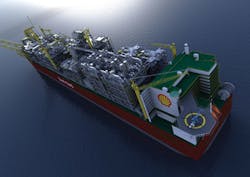Brazil, Canada, Iraq, Australia to have largest production increases
The projects in three countries with the highest increase in oil production are Brazil, Canada, and Iraq, while Australia has the projects with the highest increase in gas production, according to OGJ's review of major projects listed in the accompanying table.
The table lists projects in 44 countries that are in the construction or planning stages, with peak production from these projects occurring in 2011 or after.
If all the projects' peak production rates occurred in the same year, world production capacity would increase by 36.7 million b/d of liquids and 74.3 bcfd of gas.
The list includes both individual fields and, in some cases, the accompanying infrastructure. Listed are:
• Discoveries with announced publicly available development plans.
• Field redevelopments for recovering bypassed oil.
• Stranded-gas projects and projects to eliminate gas flaring. These projects often include new infrastructure such as pipelines for transporting gas to end users or plants for producing LNG.
• Heavy-oil projects that may include new infrastructure such as pipelines, crude oil upgraders, and mines.
• Deepwater projects, some of which rely on long flowline tiebacks and hub facilities.
• Unconventional resources such as tight sands, shale gas, and coalbed methane gas.
Although joint ventures operate some projects listed in the table, for simplification, the table lists the name of one company in each joint venture (see accompanying table listing companies' full names).
Illustration from Shell.
The year shown in the project list is when production may peak or enter a peak production plateau that could last for several years. The + after the year indicates an uncertain or yet to be determined project start-up or peak production.
Asia-Pacific
Gas projects dominate the planned developments in the Asia-Pacific region with Australia having several with a total peak production capacity of 16.5 bcfd. Australia's large projects include Greater Gorgon offshore fields that will supply gas to three 5-million tonne/year LNG trains on Barrow Island as well as gas to the domestic market. The project also features carbon dioxide reinjection and sequestration on Barrow Island. Gorgon may start shipping LNG in 2014.
Three projects in the Asia-Pacific region include floating LNG. These are Royal Dutch Shell PLC's Prelude off Australia, Woodside Petroleum Ltd.'s Sunrise-Troubadour field in the joint development area between East Timor and Australia, and Inpex Holdings Inc.'s Abadi gas-condensate field in the Indonesian portion of the Timor Sea.
Inpex has plans to develop Ichthys, a large 9.5-tcf deepwater gas and condensate project off northwest Australia.
Other LNG projects include a fifth train for Woodside's North West Shelf LNG plant that went on stream in August 2008 and Pluto field in the Burrup Park LNG project. Woodside also has plans to develop 14 tcf of gas and 37 million bbl of condensate from the Torosa, Brechnock and Calliance fields.
Several projects in Queensland in eastern Australian will convert coalbed methane to LNG.
Indonesia's largest onshore oil development is Banyu Urip field in the Cepu block on Java. Initial production of 20,000 bo/d started in 2009, but peak production is expected in 2013 at about 165,000 bo/d.
Production has been pushed back further to 2019 or after for ExxonMobil's 45-tcf Natuna D-Alpha field off Indonesia, now called East Natuna. The field discovered several decades ago contains large amounts of carbon dioxide that complicates development.
New projects will develop fields off China in both the South China Sea and Bohai Bay including the large Husky Energy Inc. gas discoveries such as Liwan that contains 4-6 tcf of gas in 1,345 ft of water.
Development of gas fields in the Southern Highlands of Papua New Guinea includes construction of a gas liquefaction plant. As now proposed, gas from reservoirs in the PNG Southern and Western Highlands would go to a 6.3 million tonne/year, two-train LNG liquefaction and storage facility near Port Moresby. The gas would come from Hides, Angore, Juha, Gobe, Moran, and Kutubu fields.
Western Europe
The UK and Norway offshore holds the main fields under development in Western Europe. Most of these fields are small and will tie into the extensive existing infrastructure in the area.
Off Norway, development continues of smaller fields.
In Italy, the onshore Tempa Rossa project will develop an estimated 200 million bbl of heavy oil reserves.
Gas production from the long-delayed Corrib field off Ireland may start in 2013.
Eastern Europe, FSU
In Kazakhstan, an $8 billion expansion of Karachaganak field will increase production by 1.6 bcfd in 2012.
Production from the first phase of the 13-billion bbl Kashagan field, off Kazakhstan, is now slated to start in 2013. With future phases, the field's production may surpass 1 million b/d.
The largest proposed development in Russia is the 130-tcf Shtockman field in the Barents Sea. The project has encountered delays because of changes in world gas demand. Gas production from the first phase of the development may start in 2016 at 2.4 bcfd with LNG exports starting in 2019. GOA Gazprom plans to sell the gas to Europe via pipelines and also build an LNG plant at Teriberka, a village 100 km northeast of Murmansk.
BP PLC's joint venture TNK-BP is developing the 1-billion bbl Verkhnechonskoye field in Russia. The company expects the field to produce 100,000 bo/d by 2015.
Middle East
International oil companies continue developing large fields in Iraq based on receiving a fee that ranges from $1.15/bbl for West Quaran 2 to $6/bbl for Najima. The timing of when this production will come on stream is speculative, but probably most of this production will not peak before 2015. Once these fields are on stream, Iraq has the potential of increasing its production by about 9 million b/d.
Kuwait continues to redevelop several fields that will increase its production capacity by 450,000 bo/d in 2012.
ADCO in Abu Dhabi is expanding production capacity in various fields by a total of 560,000 b/d Also ExxonMobil is involved in the Upper Zakum redevelopment that will increase production by about 250,000 b/d from the field.
Occidental Petroleum Corp. is ADCO's new partner for developing the Shah 1-bcfd sour gas field in Abu Dhabi.
Africa
Deepwater developments continue off Angola and Nigeria with projects involving the installation of FPSOs and subsea wells.
Also being built in Angola is a one-train LNG plant that will receive associated as well as nonassociated gas.
Nigeria also has several new LNG projects that will monetize primarily associated gas, some of which is now flared.
Western Hemisphere
Petroleo Brasiliero SA continues to make new discoveries in the subsalt of the Santos and Campos basins off Brazil. Petrobras expects the subsalt reservoirs may produce more than 1.8 million bo/d by 2020 from about 20 development projects.
Also in Brazil, OGX Petroleo e Gas Participacoes SA plans to produce 730,000 boe/d by yearend 2015 with 19 FPSOs, 24 wellhead platforms, and 5 TLPs. The developments are in shallower waters of the Campos basin.
The Waimea complex will be OGX's first development with two FPSOs and one wellhead platform, followed by Wakiki with one FPSO and one wellhead platform.
In its June report on Alberta's 2010 reserves and supply-demand outlook for 2011-20, Alberta's Energy Resources Conservation Board said that Alberta's oil sands hold 1.8 trillion bbl in place of which 177 million bbl are recoverable initially in-place resources. It expects production to reach 3.7 million b/d in 2020 up from 1.61 million b/d in 2010.
Operators and the Canadian government are still negotiating an agreement for the proposed $6 billion (Can.), 760-mile McKenzie Delta pipeline that would allow for producing the large stranded-gas resources in the Northwest Territories. First gas may not be realized until later in the decade. The large amounts of unconventional gas discovered in the US and British Colombia have reduced the importance of developing the Northwest Territory gas.
The large unconventional gas discoveries also may delay construction of gas pipeline from the Alaska North Slope. The North Slope has an estimated 40 tcf of stranded gas.
ExxonMobil has started drilling in the Point Thomson gas-condensate field on the North Slope. The company initially plans to produce the condensate and recycle the gas back into to the reservoir. Gas sales will depend on the completion of a Alaska North Slope gas pipeline.
In Alaska, there is also the Arctic National Wildlife Refuge, which has prospects that contain an estimated 10 billion bbl. These prospects might produce up 1 million bo/d if Congress allows drilling in ANWR.
Deepwater developments in the Gulf of Mexico, especially from the Lower Tertiary reservoirs, will continue to add substantial new production capacity. Chevron Corp.'s Jack and St Malo, Shell's Olympus and Vito, and Noble Energy's Gunflint-Freedom are some the larger developments planned.
Also in the gulf is Murphy Oil Corp.'s giant Davy Jones gas discovery in the deep Wilcox test well on South Marsh Island Block 230 in 20 ft of water. The discovery has estimated reserves of 2.5 tcf.
Development of shale oil and gas continues in the US in many basins in the US, although these development are not listed in the table.
Venezuela has many potential development projects, but its government's actions have created uncertainty as to their completion.
Recently Venezuela's Petroleos de Venezuela SA signed a $2 billion financing agreement with Eni SPA mainly for the Junin 5 project in the Orinoco heavy oil belt.
The development plan for Junin 5 calls for an early production phase of 75,000 b/d starting in late-2013, and a full phase of 240,000 b/d in 2018. The plan also calls for construction of a refinery on the coast, in Jose.
More Oil & Gas Journal Current Issue Articles
More Oil & Gas Journal Archives Issue Articles
View Oil and Gas Articles on PennEnergy.com
About the Author

Guntis Moritis
Production Editor
Guntis Moritis has covered production and drilling technology for the Oil & Gas Journal since January 1988. Previous to that, he worked for several major oil companies in the areas of drilling, production, and reservoir engineering. Moritis has a degree in petroleum engineering from the Colorado School of Mines.


